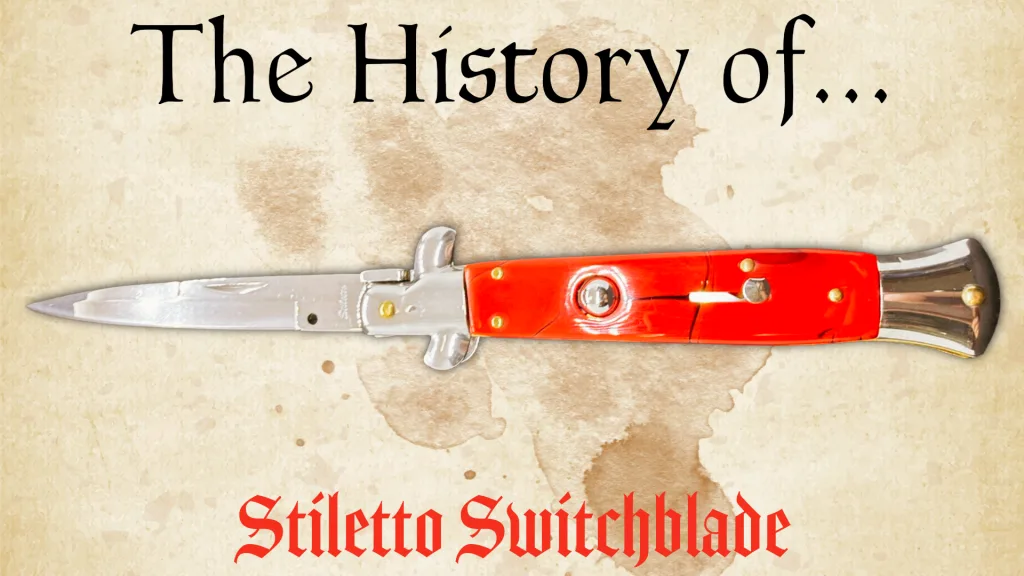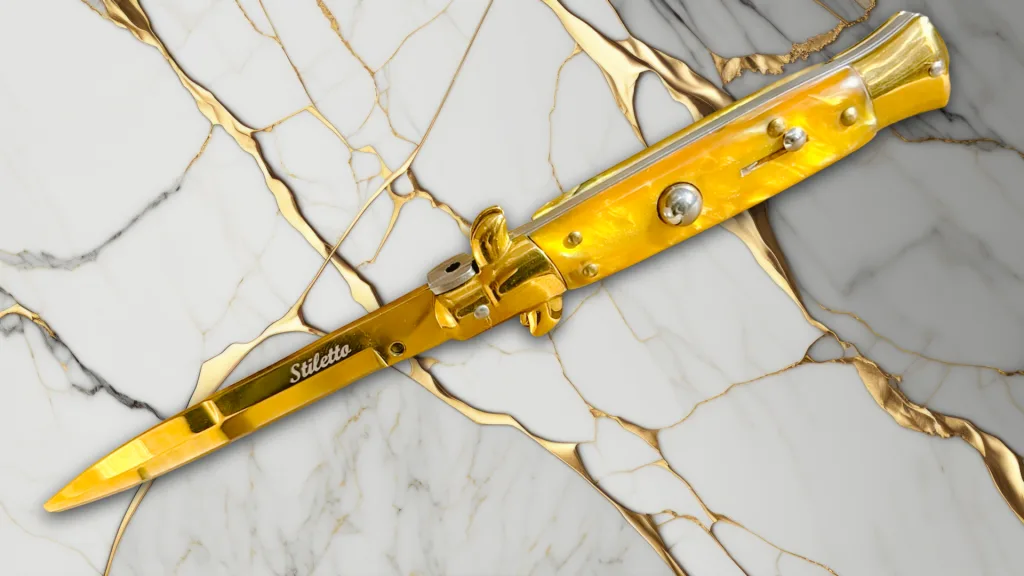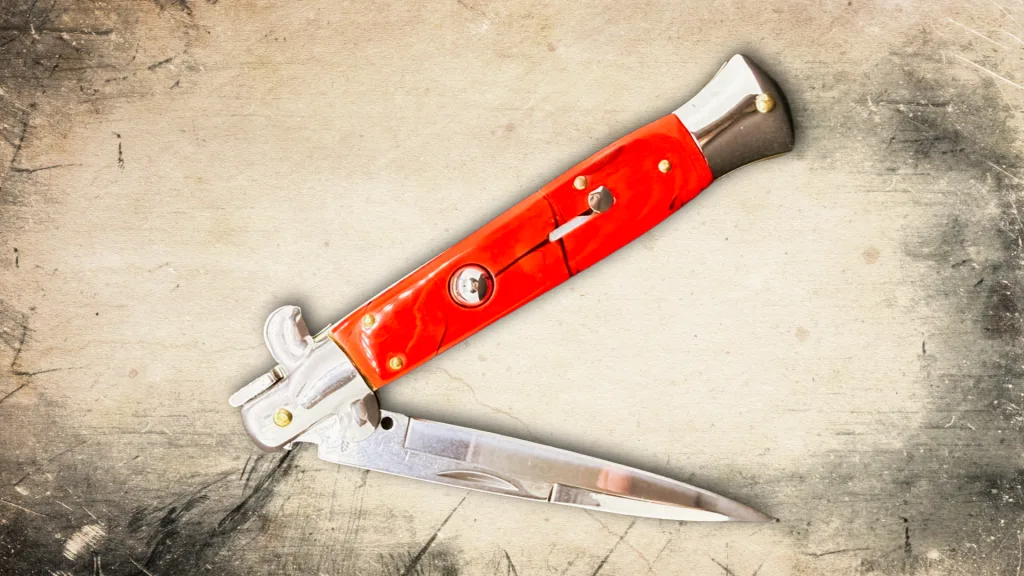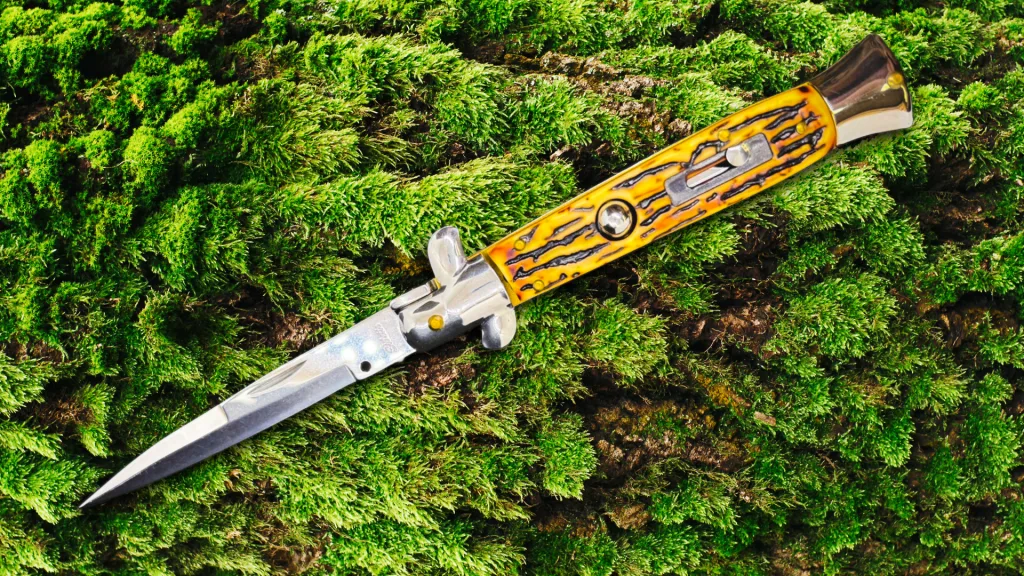
Origins: The Italian Stiletto as Dagger
The stiletto first emerged in Italy in the late 15th century as a fixed-blade dagger. It featured a very narrow cross-section and a sharp, needle-like point. Its shape focused force on a small spot—ideal for piercing armor gaps or slipping between chain mail links. TSPROF+1
Some early stilettos even lacked true cutting edges—they emphasized thrusting over slashing. Handles were often one-piece steel, turned and refined on a lathe. The name “stiletto” comes from Latin stilus, hinting at its sharp, pen-like form. Wikipedia+1
These blades gained a reputation for stealth. Hidden along a sleeve, they could deliver deep wounds with muted blood flow—ideal for assassins. By the 16th century, the stiletto had spread across Europe. In Italy, some military units carried them as backup weapons, even engraved with measuring marks to serve dual use. TSPROF+1
Transition Toward Folding Blades
In the late 18th to early 19th centuries, folding knives with springs began to appear in Europe. The idea of a blade that opens automatically was gaining traction. Wikipedia+1
In Italy, many regions began producing folding blades. Some designs retained stiletto geometry—slim, pointed blades, narrow profiles—but with lock and spring mechanisms. TSPROF+1
This was a turning point: the weapon once purely fixed now flirted with mechanics. The groundwork for a true Italian stiletto switchblade was laid.

Birth of the Switchblade Stiletto in Italy
By the early 20th century, the fusion of stiletto form and automatic opening had taken hold in Italy. Artisans in Maniago, Frosolone, Campobasso, and Scarperia crafted knives by hand, blending elegance, balance, and spring systems. LATAMA+3Wikipedia+3TSPROF+3
Pre‑World War II examples often used the “Flat Guard” design—two-piece top bolsters—and a picklock mechanism. The picklock used a spring tab under the blade that you could pry to unlock. Many blades adopted a bayonet grind: a sharp edge on one side, a false edge on the other. LATAMA+3Wikipedia+3swordsswords.com+3
Handles used traditional materials: horn, stag, wood, and occasionally ivory or mother-of-pearl. Bolsters, buttons, and guards used brass or nickel steel. Rivets were often hand-peened—a sign of true craftsmanship. LATAMA+2BladeOps+2
Over time, a simpler unlocking method emerged: the swivel (or tilting) bolster. Instead of prying a tab, the user twisted a bolster to release the blade. This design gradually supplanted picklock systems in mid-century models. Wikipedia+2BladeOps+2
Thus was born the classic Italian stiletto switchblade: long narrowing blade, slim handle, push-button release, often with a crossguard and elegant finish.
Post‑War Export Boom and U.S. Fascination
After WWII, American soldiers returning from Europe carried Italian switchblades home. These knives, unlike local utility blades, looked exotic and dramatic, and demand in the U.S. grew fast. LATAMA+3Wikipedia+3BladeOps+3
Importers flooded American shops with stilettos stamped “Made in Italy.” Young audiences and collectors embraced them. The marriage of stiletto style and automatic opening made them symbols of rebellion and sophistication. LATAMA+3Wikipedia+3BladeOps+3
During this period, many Italian blade makers shifted from picklock to swivel bolster unlocking. The older hand‑crafted style gradually gave way to parts that eased manufacturing and use—but still carried the spirit of the tradition. Wikipedia+2BladeOps+2

Pop Culture, Backlash, and Legal Battles
In the 1950s, Hollywood and media cemented the stiletto’s image. Films like Rebel Without a Cause and Blackboard Jungle made switchblade-wielding youth a cinematic trope. The snap of a steel blade became shorthand for danger. Wikipedia+2BladeOps+2
Newspapers added fuel. In 1950, Woman’s Home Companion ran a feature called “The Toy That Kills.” It claimed switchblades were as deadly as guns and warned that youths with stilettos were headed for crime. Wikipedia+2stiletto-italiano.com+2
Lawmakers responded. In 1954, New York banned switchblade sale and manufacture. Congress soon proposed a national ban. In 1958, the U.S. passed the Switchblade Knife Act, outlawing interstate trade of automatic knives. Many states followed with their own laws. BladeOps+3Wikipedia+3stiletto-italiano.com+3
Elsewhere, nations copied the U.S. model. The stigma turned what had been stylish into “criminal blades.” The Italian stiletto switchblade history thus took a pause—the blade forced underground in many places.
Underground Popularity & Collector Culture
Once regulated, civilian production in the U.S. dwindled. But collectors and enthusiasts kept interest alive. Small Italian makers continued crafting stilettos for niche markets. Some U.S. advertisers sold “kit” knives—parts you’d assemble—to circumvent import laws. LATAMA+3Wikipedia+3BladeOps+3
Collectors pursued rare makers, tang stamps, handle materials such as horn or mother-of-pearl, and vintage mechanisms. The scarcity added mystique. A beautifully preserved 1950s picklock stiletto became a treasure. BladeOps+1
As knife laws relaxed in many U.S. states and online trade expanded, the stiletto returned—now largely for art, nostalgia, and engineering appreciation rather than everyday use. Wikipedia+1
Modern Makers & Revival
Today, true Italian stiletto switchblades still come mainly from subtle artisan shops in Maniago and nearby towns. The craft remains personal, often passing from father to son.
Key names include Frank Beltrame and A.G.A. Campolin. Beltrame hand-fits each knife, pins by hand, and aims to replicate the classic snap and feel. Campolin (founded in 1947) continues patterns from small 9″ picklocks to grand display blades, embedding heritage into each build. TSPROF+2BladeOps+2
Newer editions may employ exotic steels, inlays, laser etching, or limited editions. Still, the core appeal is unchanged: sleek design, mechanical precision, and the echo of Italian legacy.

Legacy & Significance
The Italian stiletto switchblade history is more than a chronicle of weaponry. It’s a story of design evolution, cultural perception, regulatory backlash, and revival against odds.
These knives capture the tension between form and function. A blade meant for thrusting, concealed and deadly, became a symbol of rebellion and craftsmanship. Though laws once banished them, their aura endured. Today’s collectors, artisans, and fans keep the legend alive.
The stiletto switchblade remains a testament: even a small blade can carry centuries of drama, art, and identity.
FAQs
What distinguishes an Italian stiletto switchblade from other automatic knives?
It typically features a long, narrow blade (often bayonet-style), a slim profile, a crossguard or the hint of one, and a push-button mechanism—often paired with a swivel or picklock unlock.
When did Italian switchblades become popular in the U.S.?
Mostly after WWII, when returning American GIs brought back Italian-style blades and importers flooded the market.
Why did switchblade knives become illegal?
Mid‑20th-century media and moral panic linked them to youth violence. That prompted state and federal bans, culminating in the U.S. Switchblade Knife Act of 1958.
Are Italian switchblades legal now?
It depends on location. Some U.S. states have relaxed laws; others still restrict or ban automatic knives. Italy treats switchblades as “offensive weapons” under its criminal code. Wikipedia+1
Who are the major makers today?
Frank Beltrame and A.G.A. Campolin are among the most respected makers keeping tradition alive.
How can one spot a genuine vintage Italian stiletto?
Look for hand-peened pins, correct tang and maker stamps (e.g. “Maniago”), quality materials (horn, stag, mother-of-pearl), and authentic unlocking mechanisms like picklock or early swivel bolsters.






